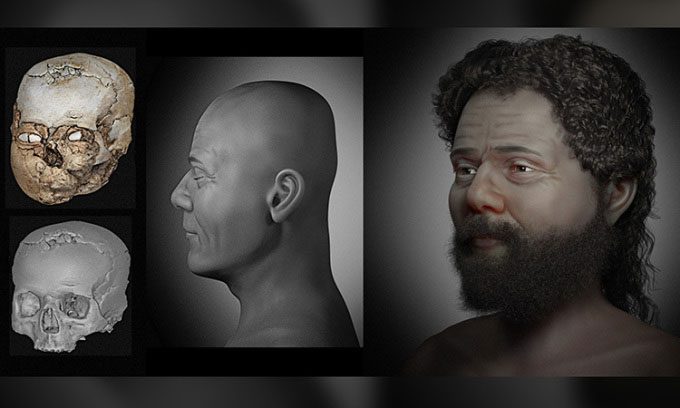Using computed tomography, experts have reconstructed the face of a man aged 30 to 40 from a elongated skull.
An international team of experts has recreated the face from a famous 9,000-year-old skull discovered near Jericho, Palestine, in 1953, as reported by Live Science on January 9. The Jericho skull was excavated by British archaeologist Kathleen Kenyon and is currently housed at the British Museum in London. When first excavated, it was covered in plaster, and the eye sockets were fitted with shells, possibly to make it resemble a living person more closely.

The face reconstruction process using new techniques. (Image: Cicero Moraes/Thiago Beaini/Moacir Santos).
In 2016, the British Museum released the measurements of the Jericho Skull based on micro-computed tomography. These measurements were then used to create a virtual 3D model of the skull, from which a preliminary approximation of the face was reconstructed. However, the new reconstruction, published in the journal OrtogOnline, employs different techniques to define the face, even adding facial hair for a more lifelike appearance.
Initially, the skull was thought to belong to a woman, but subsequent observations confirmed it belonged to a man. The new reconstruction depicts the face of a dark-haired man approximately 30 to 40 years old.
One unusual feature of the Jericho Skull is that the upper skull is significantly larger than average, according to graphic expert Cícero Moraes, the project leader. Additionally, the skull appears to have been elongated when the man was very young, possibly through binding. Some other plaster-covered skulls that Kenyon discovered also share this characteristic, but experts are still unclear about the exact reasons behind it.
Moraes did not find much detailed information about the 2016 reconstruction but noted that it seemed the experts at that time used the Manchester Method. This method, developed in 1977 based on forensic analysis, is now widely used for facial reconstruction, especially for victims in criminal cases.
However, the new reconstruction uses a different approach based on anatomical distortion and statistical projections obtained from CT scans of living individuals. This method is also utilized for planning cosmetic surgery and producing prosthetics. “I wouldn’t say this is an update, just a different approach, but it incorporates more statistics, structure, and anatomy,” Moraes stated.
Moraes hopes to create digital reconstructions for other plaster-covered skulls found by Kenyon at Jericho, but so far, only the measurements of the Jericho Skull in the British Museum have been published. “There are many mysteries surrounding these skulls. Thanks to new technology, we are discovering new things about them, but there is still much to study,” he shared.


















































